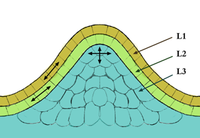
Photo from wikipedia
Rhizobial infection of legume roots during the development of nitrogen fixing root nodules can occur intracellularly, through plant-derived infection threads traversing cells, or intercellularly, via bacterial entry between epidermal plant… Click to show full abstract
Rhizobial infection of legume roots during the development of nitrogen fixing root nodules can occur intracellularly, through plant-derived infection threads traversing cells, or intercellularly, via bacterial entry between epidermal plant cells. Although it is estimated that around 25% of all legume genera are intercellularly infected, the pathways and mechanisms supporting this process have remained virtually unexplored due to a lack of genetically amenable legumes that exhibit this form of infection. In this study, we report that the model legume Lotus japonicus is infected intercellularly by the IRBG74 strain, recently proposed to belong to the Agrobacterium clade of the Rhizobiaceae. We demonstrate that the resources available for L. japonicus enable insight into the genetic requirements and fine-tuning of the pathway governing intercellular infection in this species. Inoculation of L. japonicus mutants shows that Ethylene Responsive Factor Required for Nodulation 1 (Ern1) and Leu-rich Repeat Receptor-Like Kinase (RinRK1) are dispensable for intercellular infection in contrast to intracellular infection. Other symbiotic genes, including Nfr5, SymRK, CCaMK, Epr3, Cyclops, Nin, Nsp1, Nsp2, Cbs and Vpy1 are equally important for both entry modes. Comparative RNAseq analysis of roots inoculated with IRBG74 revealed a distinctive transcriptome response compared with intracellular colonization. In particular, several cytokinin-related genes were differentially regulated. Corroborating this observation, cyp735A and ipt4 cytokinin biosynthesis mutants were significantly affected in their nodulation with IRBG74, while lhk1 cytokinin receptor mutants formed no nodules. These results indicate a differential requirement for cytokinin signaling during intercellular rhizobial entry, and highlight distinct modalities of inter- and intracellular infection mechanisms in L. japonicus.
Journal Title: Plant physiology
Year Published: 2020
Link to full text (if available)
Share on Social Media: Sign Up to like & get
recommendations!